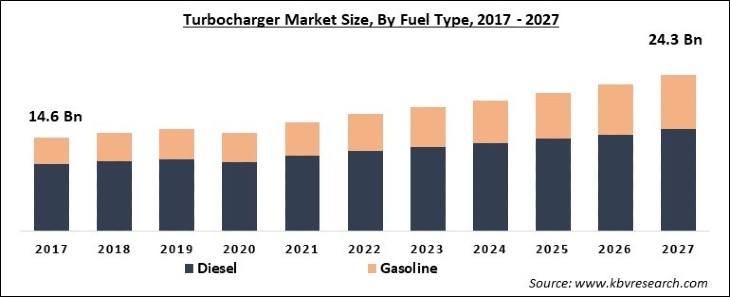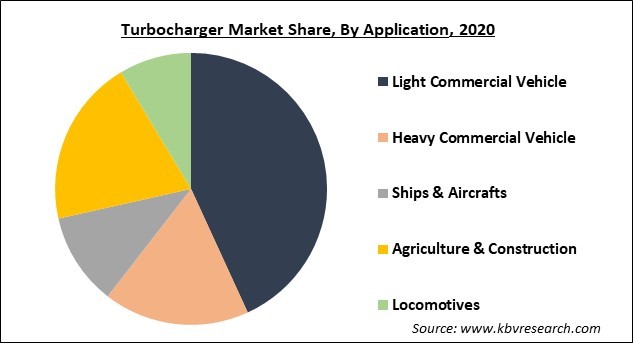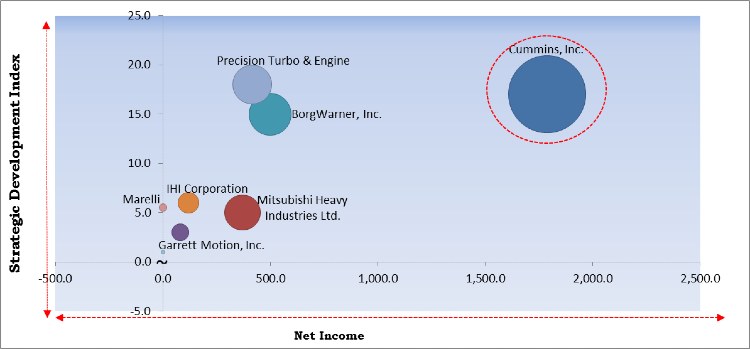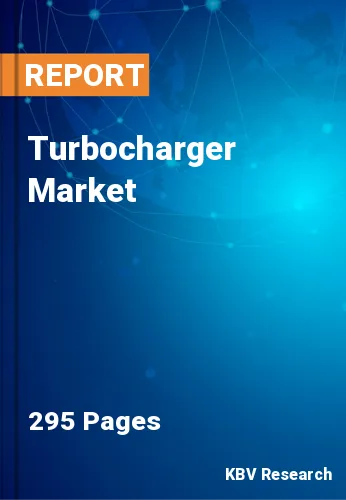The Global Turbocharger Market size is expected to reach $24.3 billion by 2027, rising at a market growth of 6.2% CAGR during the forecast period. A turbocharger is a device that is turbine-driven, which helps in increasing the internal combustion engine's power output by offering extra compressed air into the combustion chamber. In addition, a turbocharger is different from the conventional aspirated engine's power output as the compressor is able to force more air and respectively more fuel into the combustion chamber than atmospheric pressure itself. There is a wide range of applications of these turbochargers, generally in the car, truck, aircraft, train, and construction-equipment engines. These turbochargers are mostly utilized with Otto cycle & diesel cycle internal combustion engines.
Moreover, turbochargers are the important component that are used to boost the fuel efficiency by approximately 20% in automotive along with maintaining the output and torque by providing the highly pressurized air into the engines. Additionally, they help in supporting the rising power output by recovering the thermal energy discharges from the engine. By using these turbochargers in the automotive engine, manufacturers can facilitate acceleration by light pedal action and enable driving with fewer engine loads. Furthermore, the turbocharger is among the key components utilized in decreasing the particulate matter emission, and hence, resulting in cleaner exhaust. These features help in making cars, buses, and aircraft with less fuel consumption and hence, reduce environmental impact.

The COVID-19 pandemic has a huge impact on various industrial verticals including automotive, aerospace and defense, and others. The imposition of complete lockdown in various countries across the world has turned the business world upside down. The sales of automobiles have witnessed a declining demand, which has further impacted the sales of turbochargers in the market. Moreover, numerous automotive companies like Nissan, Honda, Volkswagen have faced production loss during the lockdown period.
The temporary shutdown of all the non-essential manufacturing units has negatively impacted the production of several goods. This impact has created a supply chain disruption and thus, affecting the growth of the market as a whole. Several aircraft manufacturing companies have faced a slowdown in the demand during the initial phases of the pandemic. Turbochargers are widely used in various industrial verticals, but the pandemic is estimated to slow down the overall growth of the turbocharger market over the forecast period.
Fuel efficiency is the major concern among customers because fuel prices are always fluctuating and majorly increasing, due to the restricted availability of fuel. The performance of a vehicle totally depends on the engine of the vehicle. Therefore, vehicle manufacturers are motivated to make efficient engines that can fulfill their needs and provide enhanced performance and fuel efficiency simultaneously.
Due to the increasing adoption of turbochargers across the world, several manufacturers have realized the way to fulfill the environmental emission regulations and compliances. This would result in the high production of vehicles like cars, trains, and trucks and further bolster the growth of the turbocharger market. By using turbochargers, manufacturers of various vehicles, ships, and aircraft can downsize the engine and further reduce the overall weight of the vehicle, which is a very important aspect in the production of aircraft and ships.
Turbochargers are gaining more popularity due to the various benefits offered by them and various innovations taken place in the industry, thereby supporting the growth of the market. However, there are some of the drawbacks faced by the manufacturers, which would ultimately hinder the market growth. Installation of any part in a vehicle plays an important role in the manufacturing process but if this part creates a problem for the manufacturers, then, it would possess a bigger challenge in front of the manufacturers.

Based on Fuel Type, the market is segmented into Diesel and Gasoline. The increasing penetration of alternate fuel vehicles due to the benefits like boosted fuel efficiency, cleaner sources of energy, and less cost in comparison to traditional fuel are estimated to surge the growth of the market. The key players of the market have manufactured electrical assist turbos, which are anticipated to improve systems and fuel efficiencies in electric vehicles, along with the amalgamation of motor and turbos. Hence, these product developments are anticipated to support the rising trend of electric vehicles, thus propelling the growth of the market.
Based on Application, the market is segmented into Light Commercial Vehicle, Heavy Commercial Vehicle, Ships & Aircrafts, Agriculture & Construction, and Locomotives. The light commercial vehicle segment acquired the major market share in 2020. This segment is anticipated to garner the highest share in the market over the forecast period. Though, the ships & aircraft segment is estimated to garner the promising growth rate over the forecast period.
Based on Material, the market is segmented into Aluminium and Cast Iron. The aluminum segment accounted for the largest share in the market in 2020. This segment is estimated to procure the prominent growth rate in the forecast period due to the high usage of aluminum in the manufacturing of turbochargers.
Based on Technology, the market is segmented into Twin-turbo Technology, Wastegate Technology and Variable Geometry Technology (VGT). The twin-turbo technology segmented dominated the market with the highest revenue share in 2020 and is estimated to continue its dominance during the forecast period. Though, the variable geometry technology (VGT) segment is projected to acquire the fastest growth rate during the forecast period.
Based on End User, the market is segmented into Original Equipment Manufacturer (OEMs) and Aftermarket. OEMs are increasingly shifting from diesel to gasoline engines to reduce the level of particulate matter in exhaust gases in automotive vehicles. It further helps OEM to manage the emission standards enforced by the regulatory bodies. Due to this, the diesel engine turbochargers are estimated to witness a low growth over the forecast period.
| Report Attribute | Details |
|---|---|
| Market size value in 2020 | USD 15.4 Billion |
| Market size forecast in 2027 | USD 24.3 Billion |
| Base Year | 2020 |
| Historical Period | 2017 to 2019 |
| Forecast Period | 2021 to 2027 |
| Revenue Growth Rate | CAGR of 6.2% from 2021 to 2027 |
| Number of Pages | 295 |
| Number of Tables | 524 |
| Report coverage | Market Trends, Revenue Estimation and Forecast, Segmentation Analysis, Regional and Country Breakdown, Competitive Landscape, Companies Strategic Developments, Company Profiling |
| Segments covered | Fuel Type, Application, Material, Technology, End User, Region |
| Country scope | US, Canada, Mexico, Germany, UK, France, Russia, Spain, Italy, China, Japan, India, South Korea, Singapore, Malaysia, Brazil, Argentina, UAE, Saudi Arabia, South Africa, Nigeria |
| Growth Drivers |
|
| Restraints |
|
Based on Regions, the market is segmented into North America, Europe, Asia Pacific, and Latin America, Middle East & Africa. The Europe market dominated the Global Turbocharger Market by Region 2020, growing at a CAGR of 5.8 % during the forecast period. The North America market is experiencing a CAGR of 5.9% during (2021 - 2027). Additionally, The Asia Pacific market is poised to grow at a CAGR of 6.2% during the forecast period.

Free Valuable Insights: Global Turbocharger Market size to reach USD 24.3 Billion by 2027
The major strategies followed by the market participants are Product Launches. Based on the Analysis presented in the Cardinal matrix; Cummins, Inc. is the major forerunners in the Turbocharger Market. Companies such as Mitsubishi Heavy Industries Ltd., Precision Turbo & Engine, IHI Corporation are some of the key innovators in the market.
The market research report covers the analysis of key stake holders of the market. Key companies profiled in the report include Garrett Motion, Inc., BorgWarner, Inc., Cummins, Inc., Mitsubishi Heavy Industries Ltd., Precision Turbo & Engine (Wabtec Corporation), IHI Corporation (Dai-ichi Life), Turbo Dynamics Ltd, Marelli, Magnum Performance Turbos, Inc., and Kompressorenbau Bannewitz GmbH.
By Fuel Type
By Application
By Material
By Technology
By End User
By Geography
The global turbocharger market size is expected to reach $24.3 billion by 2027.
Fuel efficiency and better engine performance would augment the market growth are driving the market in coming years, however, challenges in the installation of turbochargers limited the growth of the market.
Garrett Motion, Inc., BorgWarner, Inc., Cummins, Inc., Mitsubishi Heavy Industries Ltd., Precision Turbo & Engine (Wabtec Corporation), IHI Corporation (Dai-ichi Life), Turbo Dynamics Ltd, Marelli, Magnum Performance Turbos, Inc., and Kompressorenbau Bannewitz GmbH.
The expected CAGR of the turbocharger market is 6.2% from 2021 to 2027.
The Light Commercial Vehicle market dominated the Global Turbocharger Market by Application 2020, and would continue to be a dominant market till 2027.
Europe acquired the highest revenue share in the turbocharger market in 2020 and is estimated to maintain its dominance during the forecast period.
Our team of dedicated experts can provide you with attractive expansion opportunities for your business.

